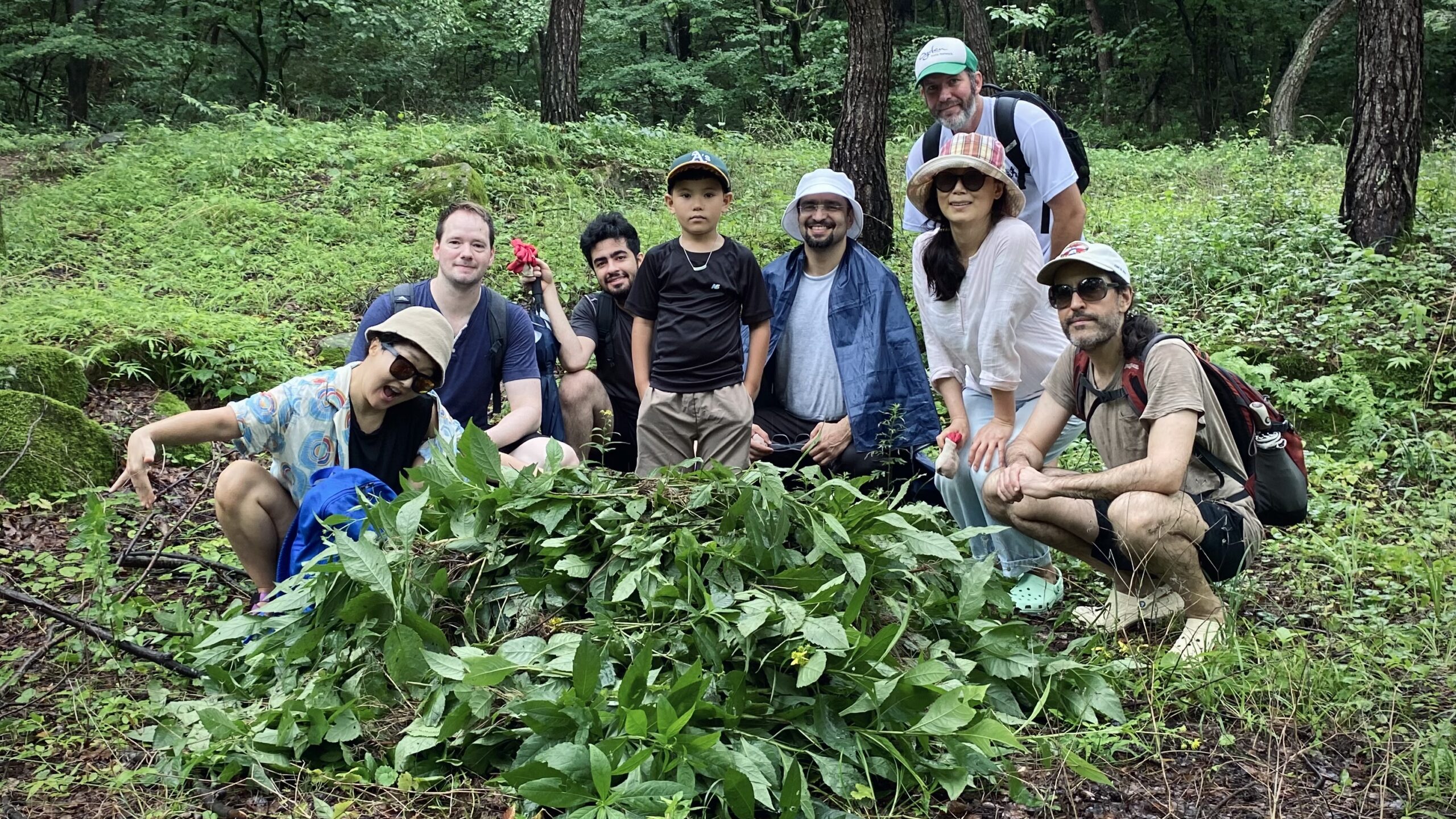Mudeung-san’s Valley Invaders
GIC Eco-Tour Uproots Invasive Wingstem Wildflower
By Isaiah Winters
While I’ve long associated the Gwangju International Center’s “GIC tours” with packed buses headed on epic overnight journeys to distant islands like Wando and Bogil-do, I’ve only recently experienced the tour’s scaled-down iteration fit for far more intimate and streamlined local excursions of fewer than ten people. It’s an entirely different vibe from what I’m used to, and yet this latest tour made just as much of an impact on me as any other. And so, in a significant departure from my usual array of “Lost” topics, this month I’ll talk a bit about the tour, the wildflower, and the valley we visited.
For this outing, local sage and eco-tour guide Warren Parsons aimed to raise awareness about an invasive yellow wildflower that’s been cropping up around Korea since the 1980s: wingstem.* Named after the winged ridges lining its stem (much like a churro), this wildflower has been competing with local flora like sasa bamboo, especially in Mudeung–san National Park where our tour took place. Koreans call this plant narae-gamaksari (나래가막사리), and efforts to curtail its spread have been a continuous thorn in the side of park rangers, as they have to do so manually.
We began the day at a bus stop in Sansu 2-dong, where a tiny handful of Iranians, Americans, and Koreans boarded bus 1187 for Wonhyo Temple. Once there, we met a young English-speaking park ranger who would assist us on the first leg of our tour: weeding part of a paved park trail before having lunch and a swim in the valley’s waters. After Warren acquainted us with wingstem and how best to remove it, the ranger handed out pairs of rubber-palmed work gloves, and then we got to work extirpating the unwelcome wildflower. To help us was the nonstop rain, which softened the dirt and kept temperatures cool as we stooped, tugged, and stacked the uprooted plants.
It’s unknown how wingstem got to Korea from its native North America, but it’s been growing a lot along roadsides and in valleys where the soil is moist and the sunshine is partial to plentiful. These wildflowers are perennial, meaning they survive for a few years despite withering aboveground during winters, and this is due to the way their long rhizomes (or underground stems) spread and produce thick colonies of roots underground. Sasa bamboo spreads the same way, and while it prefers shadier places than wingstem, the two have begun to come into contact in partially sunny places where their preferred habitats overlap.
While I’m on the topic of problematic plants, sasa bamboo and even entire pine groves in Korea also have another competitor of note: kudzu or chik (칡). This is a type of perennial vine native to East Asia that can climb up and over entire groups of trees, causing everything beneath to wither and die from lack of sunlight. Trees covered in kudzu are also more susceptible to windthrow, which is when strong winds uproot and overthrow trees. While kudzu is used in traditional Korean cooking and medicine as a hangover remedy, all the munchies and hangovers on the peninsula can’t compete with the vine’s rapid growth. It’s now even thriving in the warmer, wetter climes of the southeastern U.S., where it was first introduced from Japan in the late 19th century as a way to feed cattle, prevent soil erosion, and even shade porches.1 Though its proliferation was heavily subsidized by the U.S. government early on, now it’s largely considered a nuisance, proving that the spread of invasive species is often a two-way street.
As for the remainder of our eco-tour, we had chicken, jeon, and makgeolli for lunch and then headed deeper into the valley to swim. Along the way, I snapped a photo of some sasa bamboo that was being hemmed in by wingstem on its sunny side and covered with kudzu up top. This didn’t bode well for the bamboo. What also didn’t bode well for us on the rest of our tour was the heavy rain, which helped when weeding out wingstem but then later caused the valley waters to rage harder than any of us had ever seen. As a result, it was hard to find safe enough pools to swim in that day, though we did manage to find one area calm enough for a swim before heading home. For photogenic purposes, I’ve used some pictures from a few of my other visits to the same valley when the water was more placid. Sue me if that disappoints you.
Now on every subsequent visit to Mudeung-san, I can’t stop seeing wingstem. I’m even noticing it in old photos I took in the area years ago. And just like that, the eco-tour has opened my eyes.
* Other names for wingstem include yellow crownbeard, yellow ironweed, and even gravel weed.
Source
1 Loewenstein, N. J., Enloe, S. F., Everest, J. W., Miller, J. H., Ball, D. M., & Patterson, M. G. (2022, March 8). History and use of kudzu in the Southeastern United States. Alabama Cooperative Extension System. https://www.aces.edu/blog/topics/forestry-wildlife/the-history-and-use-of-kudzu-in-the-southeastern-united-states/
The Author
Born and raised in Chino, California, Isaiah Winters is a pixel-stained wretch who loves writing about Gwangju and Honam, warts and all. He’s grateful to have written for the Gwangju News for over six years. More of his unique finds can be seen on Instagram @d.p.r.kwangju and YouTube at Lost in Honam.





